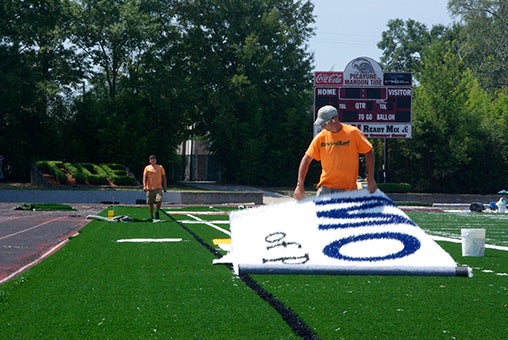How Tide stadium came to be
Published 7:00 am Friday, November 27, 2015

New synthetic turf was installed during the summer at Picayune Memorial High’s football field. File photo.
The Maroon Tide’s home football field has a long and storied history. Picayune Memorial High School Stadium was not always the grand venue that stands today.
According to the city of Picayune’s website, the first high school football game played was in 1922 in a matchup of the Tide against Gulfport.
Fred Henley who was a tailback on the Tide’s 1943 state championship team, recalled a simpler home venue.
“It had two wooden frame bleachers on each side, not near what it is now. It maybe sat 1,000 total,” Henley said.
Henley and his best friend and teammate Bill Stewart were drafted to fight in World War II and city officials in Picayune allowed them to play in the state championship game before having to leave for duty.
Immediately after winning the 1943 state championship game in Meridian against Philadelphia, Henley and his best friend, Stewart, boarded a train on a Sunday at noon from New Orleans to San Diego to begin training. Stewart died in Iwo Jima and Henley served on the Intrepid.
Henley recalls the Crosby family financing the current stadium back in 1950.
“The Crosby family built that stadium, Picayune had the finest stadium out of any high school in the state. Not many schools had the opportunity of having a concrete stadium,” Henley said.
Henley went on to become the head football coach at Picayune from 1963-65 and then became superintendent of schools in Picayune.
The Crosby family supported building the high school that’s there now which was dedicated to the memory of those who lost their lives in World War II.
“I became superintendent in 1976 and retired in 1986 with 40 years in public education,” Henley said.
Current Head Coach Dodd Lee, who played at Picayune from 1972-1975 said they used to dress underneath the stadium because they didn’t get a field house until 1994. Before the field house, Picayune had no weight room or any football meeting rooms. Lee said the structure of the stadium has been the same since the 1940s with the exception of the press box addition.
Around 2009 the old cinder track around the field was replaced with a leather track, which Lee said was a huge asset to all athletic programs in the school.
This past summer the school made the big switch from grass to synthetic turf, which requires significantly less maintenance. They made good use of the sod by selling it to the city for use at Crosby Commons, according to the city of Picayune’s website.
Since 1996, Lee has been the head coach at Picayune and until the turf field was installed this past summer, he cut the grass three times a week to maintain the field. Also, he said the drainage of the grass field was posing huge problems on the field because they would have to fill up sinkholes and drain puddles constantly.
He is extremely happy with the new playing surface.
“All I know, is I can feel the difference at the end of the season and ours is the best I’ve encountered and it doesn’t cause a lot of abrasions on the players,” Lee said.



